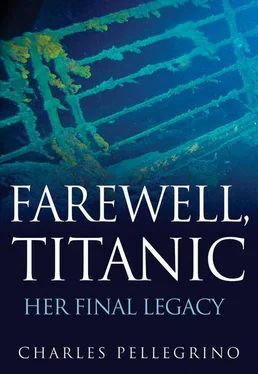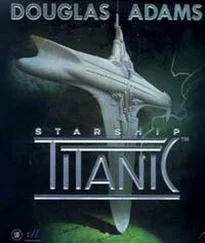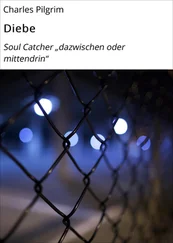THE EXAMINATION
Among the moments Steward Hardy would keep coming back to, in his seventies, were the odd questions of his American examiners.
“When did you ship with the Titanic ?” Senator Duncan Fletcher asked.
“I shipped with her on her last voyage,” Hardy replied.
“In what capacity?”
“As second-class steward.”
“Did anything unusual happen on that voyage?” the senator asked.
That probably depended, Hardy supposed, on whether being awakened by an iceberg and then being roused by Purser Reginald Barker from first class—who normally never came down to second class—counted as anything unusual. No, nothing out of the ordinary happened until about that time, Hardy told the senator.
• • •
The Antarctic explorer Sir Ernest Shackelton had no doubts about what happened to the Titanic and why. He knew that without moonlight over a dark sea on which no successions of waves were breaking at the feet of icebergs, there could be no starlight reflected from white foam and no disturbance of bioluminescent marine animals like comb jellies to reveal an iceberg a mile away. He knew from experience that on excessively calm nights sea ice became “black ice,” and a skipper did not want the eyes of his ship looking down from an angle more then ninety feet high in the crow’s nest, but rather from low in the bow of the ship, looking out from a point as near as possible to Krekorian’s angle, across the surface of the sea toward the starlit horizon.
Shackelton also knew from experience that on a night with no wind, the sudden drop of air temperatures, which had sent the passengers indoors less than two hours before impact, was a clear indication that the Titanic was approaching an ice field, if the warnings from the Baltic and La Bretange were not already enough. Passenger Emily Ryerson had thought that Bruce Ismay, the Titanic ’s owner, was rebuffing her after he showed her one of the ice warnings and after she responded with a suggestion that the Titanic should be slowed down, but Shackelton knew that had Ismay or anyone else in his industry listened to his passenger, he might never have been called to explain to Lord Mercey’s committee how the Titanic came to be the subject of bio-archaeology for explorers of the future.
“And you think all these liners are wrong,” the examiner asked the explorer, “in following the accepted standard of putting the danger quickly behind by going at top speed in regions where ice is reported?”
The examiner turned incredulous when Shackelton explained that in the vicinity of Antarctic ice he had slowed his research vessel—which had been built specifically to resist ice—to only four knots.
“Then where did that get you to?” the examiner asked.
“We got very near the South Pole, my lord.” He did not have to emphasize that they got there and back alive.
The examiner pressed the question: Whether he was in an icebreaker or in a ship whose floatability had been enhanced by dividing it into a series of watertight containers, would he slow down?
“I would slow down, yes,” Shackelton replied.
“And supposing you were going twenty-one and three quarters to twenty-two knots?”
The explorer summed it up in thirteen words: “You have no right to go at that speed in an ice zone.”
• • •
“I think the damage is serious,” Barker said, and then he brought Hardy forward and showed him a flooded crew compartment stairwell in which the water was rising much faster than it would be in a small bathtub with the faucets opened all the way. At the top of the stairs, a newly installed water fountain for the firemen and the coal trimmers was about to be overtaken by this unnatural indoor tide. Even after Hardy was asked to assist in closing additional watertight doors along F deck, he still had confidence that the Titanic would remain afloat.
Hardy had been advised by Barker to get the passengers on deck with their life jackets—“just as a precaution.” As he ran along a second-class corridor, he personally woke passengers in at least twenty cabins by loudly banging on their doors while shouting, “Everybody on deck with life belts on, at once.” He was most likely the mysterious savior who woke young Madeline Mellinger.
Unlike Madeline and her mother, the entire Laroche family had slept through the impact and were not awakened until a steward banged on the door and ordered them up to the top deck. To Juliette Laroche, the ship had seemed from the very first day to be “a monster,” as she wrote in a letter to her father, posted from Queenstown, Ireland, on April 11, 1912. Although Juliette’s nonwhite husband, Joseph, was not permitted to hold a first-class ticket, the prejudicial norms of the Gilded Age had played no role in the inception, from day one, of her belief that something wicked had come into her life, clothed in steel. Her concerns went deeper than the physical surroundings of second-class accommodations—which she found to be wonderful, externally. Indeed, Juliette echoed the consensus view that the arrangements in second class could not have been more comfortable were they traveling first-class on another ship.
“The boat set out [from France] while we were eating, and we could not believe we were moving,” Juliette wrote to her father. She had thus far met only one other couple on the Titanic who could speak French, but this did not seem to matter to the children. Little Simonne had amused her mother by “playing with a young English girl who lent her [a] doll. My Simonne was having a great conversation with her, but the girl did not understand a single word.”
Nevertheless, despite the comforts of the reading room from which Juliette posted her letter—“There is a concert here, near me: one violin, two cellos, one piano”— she wrote that there did indeed appear to be something monstrous about the ship, giving her and Joseph “a slight trepidation.”
And now had come the loud bang at the door and a cry of warning. Joseph, who spoke English fluently, sought out a deck steward, an officer, or anyone else who might possess information. He came back with news that the Titanic had suffered an accident, and his instincts told him that the monster might sink. He bundled the children in warm clothing, gathered Juliette’s money and jewels, and led the family toward whatever fate awaited them near boat 10, where Second Officer Charles Lightoller would soon be working under the twin assumptions that the new lifeboats were as frail and risky as older models and could be launched only half full. To him, this meant that what little space remained in the boats was not to be occupied by adult male passengers—and especially not by passengers of the second and third classes.
Another officer in command of the same string of portside lifeboats would soon be arriving on the boat deck to become a double barrier against Joseph Laroche’s chances of survival. Fifth Officer Harold G. Lowe was a man very quick to draw his gun against nonwhites approaching the boats. He generally regarded them as dangerous and glaring, like animals.
Juliette had learned only recently, while planning for her family’s new life in Haiti, that she was pregnant with their third child, who would now have the peculiar distinction of becoming a Titanic survivor who did not appear on any passenger lists.
Ellen Phillips, like the yet-to-be-named Joseph Laroche Jr., was absent on account of not having been born yet. Her father was Henry Marshall, but his real name was Henry Morley, and he was not married to his traveling companion, “Mrs. Marshall”—who was really his nineteen-year-old shop assistant, Kate Phillips—but to another woman. From the first seconds of impact, Ellen was embarking on one of the legal world’s longest episodes of abandonment and delaying tactics. Her paternity and inheritance claims would remain unresolved from the beginning of one century into the beginning of the next. Though yet to be born, the daughter of Henry Morley was already heading into a maelstrom of broken promises, dying dreams, the emerging cruelty of a young mother on the path to insanity, the false hopes of a mad dash aboard the Titanic to a secret life in San Francisco, and a final parting gesture of devotion in the form of a blue sapphire necklace later to be called “Love of the Sea.”
Читать дальше











